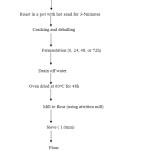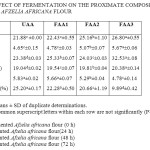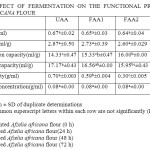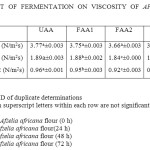Introduction
Mahogany bean Afzelia africana is an underutilized legume plant in the family of Fabaceae sub family caesalpiniaceae. It is a deciduous tree and is known as counter wood tree or African oak. It is widely distributed and consumed by many African countries including Senegal, Sudan, Uganda, Tanzania, Sierra Leone, Ghana and Nigeria. It is also found in South Asia-India. It is known by different names in Nigeria. It is called “yiase”; among the Tivs,, “akparata”among the Ibos and “apa” “ukpo” “kawa” among the Yorubas, Idomas and the Hausa people of Nigeria respectively (Keay et al, 1964).1 Although 1t is widely distributed, it has being classified as vulnerable due to over exploitation for timber on the international market.IUCN.2
Reports by few researchers have shown that Afzelia africana is an excellent source of protein as well as soluble dietary fibre.( Ene- Obong and Carnovale,3 1992, Odenigbo, 2001). Soluble dietary fibre has beneficial effects on blood glucose and lipid levels in diabetes mellitus, it lowers blood pressure and serum cholesterol.( Anderson et al, 1999,5 Guevin et al. 1996).6 It also offers protection against cardiovascular diseases, obesity and colon cancer. Ubon,DE (2007).7 It has relatively high quantities of iron, zinc, phosphorus and exceptionally high calcium. Afzelia africana cotyledons are used as soup thickeners and its leaves are fermented and used for preparing yam potage. Every part of the plant is of great importance. The wood is used for carpentry, the sawdust is utilized for art work, the foliage is used for animal feeds, the ashes from the pods are used in soap making and the leaves contain high amount of nitrogen for enrichment of the soil.Acland, 1980.8
Many researchers all over the world are working on various sources of plant proteins to increase the nutritional value and safety of foods at low price.9 (Gorinstein et al, 2002; Legumes are good sources of dietary vegetable proteins and minerals that compare with animal proteins from meat, egg and fish except the high cost of animal proteins.10 Apata 1997.
Legumes however contain a variety of toxic constituents as well as anti-nutritional factors such as phytates, trypsin inhibitor, saponin, haemagglutin, tannin, protease inhibitor, oxalate, and goitrogen.10Apata DF and Ologhobo AD, 1997. These compounds tend to lower protein digestibility and bioavailability of the minerals.
Many researchers have reported that processing legumes by soaking, blanching, boiling, roasting, germination and fermentation decrease the anti nutrients, improve nutritional value, digestibility and leads to increased bioavailability of the minerals.11-13 Nout 2009, Murwan, KS and Ali AA, 2011, abd, ahmed, Bishoi and Taiwo. In developing countries like Nigeria, attention is being drawn to harness low cost but high quality plant proteins to combat protein energy malnutrition and enhance nutrition and food security of the teeming population. However little information is in literature on the fermentation of mahogany beans.
The fermentation of Afzelia africana would increase the digestibility of the proteins, reduce anti-nutritional factors, and enhance the flavour and colour of the afzelia Africana flour. The flour would be utilized in production of many food products apart from the present uses.
Fermentation is also important to reduce food losses and increase food availability.14 Aworh, 2008
The aim of the work is therefore to use fermentation processing to produce Afzelia Africana flour, study the proximate composition and functional properties to enhance its use in different food formulations and recipes.
Materials and Methods
Source and preparation of raw materials
Five kilograms of mahogany bean (Afzelia africana) seeds were purchased from a local market and brought to the Food Chemistry Laboratory in clean polyethylene bag. About 4 kg of the mahogany seeds were sorted, de-capped, winnowed and cleaned to dislodge dust, foreign matter, stones, broken and defective seeds. The seeds were roasted for 3-5minutes to aid dehulling. The dehulled seeds were then divided into four (4) portions which were fermented naturally at 0, 24, 48 and 72 hrs respectively, oven dried and milled into flours as shown in figure 1.
 |
Figure 1: Production of unfermented and fermented Afzelia africana flo Click here to View figure |
Fermentation of the Afzelia Africana
Natural fermentation was carried out by mixing each sample with distilled water at a ratio of 1:2 w/v. The samples were incubated in an incubator at 30º C and samples were withdrawn at periods of 0, 24, 48 and 72 h. After the fermentation period each sample was transferred to an aluminum dish and dried in a hot air oven drier at 60º C for 48 h. Dried samples were finely ground, sieved and stored in polyethylene bags at 4ºC for subsequent analysis.15
Proximate Analysis of the flours
The Association of Official Analytical Chemists (AOAC 1990)16 standard procedures were used for the determination of moisture content (14.062), crude fat (14.066), protein(14.067), crude fibre (14.064) and ash (14.063). Total carbohydrate was calculated by difference.
Water Absorption Capacity
The water absorption capacity was determined according to the method of Beuchat.17 One g of sample was mixed with 10 mL of distilled water for 1 min and then centrifuged at 5000 g for 30 min. After separation of the content, the volume of supernatant was recorded. Water absorption capacity is expressed as gram of water absorbed per milliliter of sample, g/mL.
Bulk density (g/ ml) = W1- W2/ Volume of sample before tapping
W1= weight of sample before tapping
W2= weight of sample after tapping
Foaming capacity (FC)
This was determined by the method described by Coffman and Garcia.18 About 2 g of sample was blended with 100 ml distilled water in a Kenwood blender. The suspension was whipped in an ace homogenizer (NSEIAM-6) at 1600rpm for 5 minutes. The mixture was poured into a 250ml graduated cylinder and the volume was recorded after 30 seconds. The foaming capacity was expressed as percentage increase in volume using the formula:

Oil absorption capacity
One g of sample was mixed with 10 mL of vegetable oil . The mixture was stirred for 30 min at room temperature then centrifuged at 2500g for 30 min, the supernatant was transferred to a graduated cylinder of 10 mL, where the volume was measured. The oil absorption capacity was expressed as milliliters of vegetable oil held per gram of sample.19
Swelling Capacity
Swelling capacity was determined according to the method given by Robertson et al.,20 About 100 mg of the sample was mixed with 10 mL of distilled water in a calibrated cylinder at room temperature. After equilibration for 18 hr, the bulk volume was recorded and swelling capacity expressed as volume occupied by sample per gram of original sample dry weight.
Swelling capacity % = change in volume of sample/ original weight of sample.
Least gelation capacity
This was determined by the method described by.21 2%, 4%, 6%, 8%, 10%, 12%, 14%, 16%, 18%,and 20%, (w/v) of sample in 5ml distilled water in test tube were heated for 1 hour in boiling water. The test tubes were further heated for 2 hours at 400 and least gelation capacity was determined as the ability of the sample to flow out or not when the test tube was inverted.
Viscosity
Viscosity was determined by the method described by Mosha and Senberg.22 Ten grams of sample was weighed and emptied into a beaker after which 100ml of water was added. The mixture was then stirred properly and heated in a boiling water bath at 90oC for a period of 20 minutes. Further heating for 15minutes with occasional stirring was carried out. The beaker containing the sample was then transferred to another water bath maintained at 45oC and the viscosity was determined at this temperature. A spindle number 2 from a Brookfield viscometer ( model LV8) was used. The effect of stirring speed was determined by comparing the speed of 3,6, and 12 rpm respectively. Measurements were in duplicates.
Statistical analysis
All the data were subjected to analysis of variance (ANOVA) as described by.23 The means were then separated with the use of Duncan’s multiple range test using the statistical package for the social sciences, SPSS 19.0 software.
Results and Discussion
Proximate Analysis of the flours
The result of the proximate composition of Afzelia africana flour as affected by fermentation is shown in Table 1. The protein , crude fat , crude fibre and moisture contents of Afzelia africana flour increased with increase in fermentation period and they were significantly different at 5% level of probability. The values of the protein content ranged from 21.88- 26.80%, while that of crude fat, crude fibre and moisture contents ranged as follows: 23.38-32.53%, 19.04-20.38% and 4.65-5.65% respectively. Similar observations were made by Udensi and Okoronkwo24 while studying the effects of fermentation and germination on the physicochemical properties of Mucuna cochinchinensis protein isolate flours fermented for 72 hr. Nnam25 also observed increase in protein, lipid and ash levels during fermentation of cowpea meal. The increase in ash content is however contrary to observation in this work. The work by Igbabul, et al.,26 and Torres et al.,27 on the fermentation of Mucana sloanei and Detarium microcarpum and pigeon pea revealed increase in moisture, protein and crude fibre contents.
 |
Table 1: Effect of Fermentation on The Proximate Composition of Afzelia Africana Flour |
The increase in crude protein values could be attributed to increase in microbial mass during fermentation causing extensive hydrolysis of the protein molecules to amino acid and other simple peptides. The increase in crude protein is an indication that Afzelia africana could be a source of high quality plant protein for people that cannot afford animal protein in their diets.
The increase in crude fat could be a result of extensive breakdown of large molecules of fat into simple fatty acids. The increased levels of dietary fibre in fermented Afzelia africana shows that it would provide dietary fibre that would offer protection against cardiovascular disease, obesity and colon cancer and promote the effective functioning of the human digestive tract as reported by Ubom.7
Fermentation of afzelia Africana led to the significant (P<0.05) decrease in ash content and quantity of carbohydrate with increased fermentation time. Similar trend was reported by Igbabul,et al.,26and Ogbonnaya et al.,28 in their fermentation work on Mucana sloanei and Detarium microcarpum and locust bean. The loss in ash content may be due to leaching of soluble minerals into the processing water during the fermentation period or the fermenting microorganisms might have used it for metabolic activites.29,25,28,30 The decrease in carbohydrate content could be attributed to the conversion of oligosaccharides to simple sugars or the utilization of the carbohydrate nutrient as source of energy by the fermenting microorganisms for growth and metabolism.31-32
Functional properties of the flour
The result of the functional properties of the Afzelia Africana flour is presented in Table 2. The bulk density and swelling capacity did not show any significance (P>0.05) difference with increase in fermentation period. The bulk density varied from 0.62-0.67g/ml with the unfermented flour having the highest value of 0.67g/ml and the 72h fermented flour had a value of 0.62g/ml. The result agrees with the findings of 24 Similar result was reported by Onimawo et al.,33 in their work on fermented bambara nut. The decrease in bulk density of the fermented afzelia africana flour would enhance its usage in infant and child food formulations. Fermentation has been reported as a traditional and important processing method used in infant and child food preparation.34
 |
Table 2: Effect of Fermentation on The Functional Properties of Afzelia Africana Flour |
The swelling capacity of Afzelia africana flour decreased with increasing fermentation time. It ranged from 2.50-2.87 g/ml. The unfermented flour had the highest value of 2.87g/ml and decreased to 2.50g/ml after 72 h. This result compares with Adebowale and Maliki,35 who reported that fermentation reduced the swelling capacity of pigeon pea flour. The swelling capacity is due to the amount of amylopectin fraction in starch which is subject to degradation during fermentation.36
The water absorption capacity of afzelia africana flour increased significantly (P<0.05) with increase in fermentation time ranging from 16.33-14.33g/ml.The unfermented flour had a lowest value of 14.33g/ml and recorded the highest value of 16.33g/ml after 72h fermentation. Some researchers reported that fermentation significantly (P< 0.05) decreased the water absorption capacity of food flours. Singh et al.,37 reported on sorghum, pearl millet and maize, Udensi and Okoronkwo24 reported on Mucana beans and Elkhalifa et al.,38 reported on sorghum flour respectively. Water absorption capacity was however reported by Igbabul et al.,26 to increase significantly with increase in fermentation time for the two legumes studied. Water absorption capacity gives an indication of the amount of water available for gelatinization. Higher absorption capacity is desirable for making bakery products.
The oil absorption capacity of Afzelia africanca decreased with increase in fermentation period it ranged from 17.17g/mg for the unfermented flour to 15.33g/ml after 72 h of fermentation. Igbabul et al.,26 reported decrease in oil absorption capacity for the two legumes studied but values were lower than the values in the present work. Elkhalifa et al.,38reported increase in oil absorption capacity in the fermentation of some cereals.
The foam capacity decreased with increase in fermentation period ranging from 0.70-0.10g/ml.
The unfermented flour recorded the highest value of 0.7g/ml which decreased to 0.1g/ml in the fermented flour. Similar results were reported by26 and.35
Foam formation and stability depend on the type of protein, pH, processing method, viscosity
and surface tension.39 Foam stability is important since the usefulness of whipping agents depend on their ability to maintain the whip as long as possible.
The least gelation concentration of Afzelia africana flour was not affected by fermentation. A constant value of 0.8g/ml was recorded for the period of fermentation.
The result of effect of fermentation on the afzelia africana flour is presented in Table 3. The viscosity was carried out at the speed of 3, 6 and 12 for the fermentation period of 0-72 h. At speed 3, the values ranged from 3.77 N/m2s for the unfermented flour to 3.65 N/m2s for the fermented flour for 72 h. The values at speed 6 and 12 are recorded as 1.89-1.83N/m2s and 0.96-0.9 N/m2s respectively. The viscosity decreased with increased fermentation time and increased speed. The decrease in viscosity could be attributed to the breakdown of complex carbohydrate into simple sugars and compounds.
 |
Table 3: Effect of Fermentation on Viscosity of Afzelia Africana Flour |
Fermentation processing increased the protein content, crude fibre, and crude fat of the Afzelia africana flour with enhanced functional properties. The flour can thus be utilized in food formulations for malnourished children, women, lactating mothers and the elderly people. It would also be used as a source of plant protein for the people that cannot afford animal proteins. The vegetarians would also find it useful in their diets. Fermentation processing would enable availability of afzelia africana flour all year round with improved shelf life and thus food security. The increase in fibre content would impart probiotic effect on the consumers by promoting effective functions of the human digestive system.
Refrences
- Keay, R.W.J., Onochie, C.F.A and Stanfield, D.P. Nigerian Trees. Vol. 1 Department of Forest Research, Ibadan, Nigeria.pp 51-54(1964)
- IUCN, 2004. IUCN Red List of Threatened Species. Searchable database at http://www.iucnredlist.org/ (accessed January2005).
- Ene-Obong, H.N. and Carnovale, E. Food Chem. 43, 169-175(1992)
CrossRef - Odenigbo, U.M. Obizoba, I.C. Journal of Biomedical Investigation 2,2, 86-91(2004)
- Anderson J. Allgppd. L. Turner, J.Oelrgen, P. and Daggy, B.P. Am.J.Clin Nutr 70,4,466-473(1999)
- Guevin, N. JacquesH. Naddean, A. Galibois, L.J. Am Colle Nutr 15, 389-96 (1996)
- Ubom, D.E. Nutrition, health and our environment. Sendina Ltd, Nigeria. Pg 140 (2007)
- Acland, J.D. East African Crops:An Introduction to the Production of Field and Plantation Crops in Kenya, Tanzania and Uganda. FAO/Longman Group Ltd, London.(1980)
- Gorinstein, S., Pawelzik, E., Delgado-Licon, E., Haruenkit, R., Weisz, M., & Trakhtenberg, S. Journal of the Science of Food and Agriculture,82, 886–891(2002)
CrossRef - Apata, D.F and Ologhobo, A.D. Tropical Science. 37, 52-59(1997)
- Nout, M.J.R. Food Microbiology. 26, 7, 685-692
CrossRef - Murwan, K. S., Ali, A.A. Journal of Applied Biosciences. 39, 2602-2606(2011)
- Abd El-Moniem, G.M., Honke J. and Bednarsaka A. Journal of Science of Food and Agriculture, 80, 57-62 (2000).
CrossRef - Aworh, O.C. J. Rec. Adv. Agri. 1,4, 92-102 (2008)
- Mohiedeen, I. E. Tinay, A. H. E. Elkhalya, A. E. O. Babiker, E. E. and Mallasiy, L. O. Elec. J. Env. Agricult. Food Chem. 9, 838-847(2010)
- AOAC Official Methods of Analysis 15th edn. Association of Official Analytical Chemists Washington D.C. (1990).
- Beuchat, L. R. J. Agric. Food Chem. 25, 258–261(1977)
CrossRef - Coffman, C.W. and Garcia, V.V. (1977). Functional properties and amino acid content of a protein isolate from mung bean flour. J. Food Technology, 12, 473-484.
CrossRef - Chau, C. F. and Huang, Y. L. Journal of Agricultural and Food Chemistry. 51, 2615–2618(2003)
CrossRef - Robertson, G. L. Monredon, F. D. Dysseler, P. Guillon, F. Amado, R. Thibault, J. F. Lebensm. Wiss. –Technology. 33 72–79 (2000)
CrossRef - Sathe,S.K., Deshpande, S.S. and Salunkhe, D.K.J. Food Sci. 47:503-509 (1982).
CrossRef - Mosha and Senberg. The United Nations Universitties Food and Nutrition bulletin. 5, 2, 10-14(1983)
- SAS(statistical Analytical System), (1999)
- Udensi, E.A. and Okoronkwo, K.A. (2006). Afri. J. Biotech. 5, 10, 896-900.
- Nnam, N.M. Ecology of Food and Nutrition. 33,273-279(1995)
CrossRef - Igbabul, B.D., Idikwu, H.O. and Inyang C.U. J. Food Technol. 10,3, 83-86 (2012)
- Torres, A. Frias, J.., Granito, M. Vidal-Valverde, C. J. Agric. Food Chem. 54, 6685-6691(2006)
CrossRef - Ogbonnaya, C.A., Orhevba, B.A. and Mahmood, B.A. Journal of Food Chemistry. 8,3, 99-101(2010)
- Osman, M.A. Pakistan Journal of Nutrition. 6, 299-303(2007)
CrossRef - Reebe, S., Gonzalez, V.N. and Rengifo, J. Food and Nutrition Bulletin, 2, 387-391(2000)
- Enwere, J.N. Foods of plant Origin. Afro Orbit publishers Ltd, Nsukka, Nigeria. 15-50(1998)
- Omafuvbe, B.O., Falade, O.S., Osuntogun, B.A. and Adewusi, S.R.A. Pakistan Journal of Nutrition. 3,140-145(2004)
CrossRef - Onimawo, I.A., Momoh , A. H. and Usman, A. Plant Food Hum. Nutr. 53, 153-158(1998)
CrossRef - Desikachar, H. S. R. Food Nutr. Bull. 2 21–23(1980)
- Adebowale, O. J. and Maliki, K. International Food Res. J. 18, 4, 1329-1333(2011)
- Tester, R.F., Morrison, W. R. Cereal Chemistry.67,551-557.
- Singh, A., Yadav N. and Sharma, S. Intl. J. of Agri. and Food Sci. 2,3, 66-70(2012)
- Elkhahalifa, A. E. O. Schiffler,B. and Bernhardt, R. Food Chem. 92,1-5 (2005)
- Yasumatsu, K., Sawada, K., Moritakas, S., Misaki, M.,Toda, J., Wada, T. and Ishii, K. Journal of Agriculture, Biology and Chemistry 36: 719-728(1972)

This work is licensed under a Creative Commons Attribution 4.0 International License.




